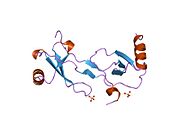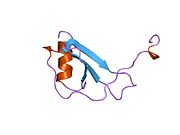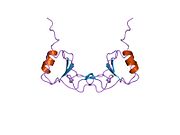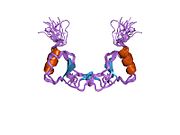CCL2
CCL2, hemokin (C-C motiv) ligand 2, je mali citokin iz CC hemokin familije koji je takođe poznat kao monocit hemotaksni protein-1 (MCP-1), i mali induktivni citokin A2. CCL2 regrutira monocite, memorijske T ćelije, i dendritske ćelije na mesta povrede tkiva i infekcije.[1][2][3]
Genomika
[уреди | уреди извор]Kao i mnogi drugi CC hemokini, CCL2 je lociran na hromozomu 17 (17q11.2-q21.1) kod ljudi.[4] Ovaj gen sadrži 1,927 baza i nalazi se na Vatson (plus) lancu. On ima tri eksona i dva introna. CCL2 nastaje kao proteinski prekurzor koji sadrži signalni peptid sa 23 aminokiseline i krajnji peptid sa 76 aminokiselina.[5][6] Molekulska težina je 11.025 kDa. Mišji homolog je Sig-je.
Populaciona genetika
[уреди | уреди извор]Nivoi ovog proteina značajno variraju kod normalnih ljudi. Multivarijabilna-prilagođena naslednost MCP-1 koncentracija kod ljudi evropskog porekla se smatra da je 0.37 u plazmi i 0.44 u serumu[7][8].
Molekularna biologija
[уреди | уреди извор]Ovo je monomerni polipeptid, sa molekulskom težinom od približno 13 kDa. On je vezan za endotelijalne ćelije putem glikosaminoglikan bočnih lanaca proteoglikana. Njega prvenstveno izlučuju monociti, makrofage i dendritske ćelije. On je trombocit izvedeni faktor rasta induktivni gen. On se razlaže metaloproteinazom MMP-12.
Receptori na ćelijskoj površini koji vezuju CCL2 su CCR2 i CCR4.[9]
Ovaj citokin deluje kao hemoatraktant za monocite i bazofile ali ne za neutrofile ili eozinofile. Brisanje N-terminalnih ostataka konvertuje ga iz aktivatora bazofila u eozinofil hemoatraktant. CCL2 uzrokuje degranulaciju bazofila i mast ćelija. Ovaj efekat je pojačan pre-tretmanom sa IL-3 i drugim citokinima.[10][11] On menja monocitnu antitumorsku aktivnost, i on je esencijalan za formaciju granuloma.
Ovaj hemokin se može naći na mestu izvijanja zuba i degradacije kostiju. U kostima, CCL2 izražavaju osteoklasti i osteoblasti, i on je pod kontrolom nuklearnog faktora κB (NFκB). Za MCP-1 i RANTES je bilo pokazano da indukuju formaciju TRAP-pozitivnih, multinuklearnih ćelija iz M-CSF-tretiranih monocita u odsustvu RANKL, ali proizvode osteoklaste kojima nedostaje katepsin K ekspresija i resorptivni kapacitet. Predloženo je da CCL2 i RANTES dejstvuju kao autokrina petlja kod ljudske osteoklastne diferencijacije.[12]
Klinički značaj
[уреди | уреди извор]CCL2 je bio impliciran u patogenezu bolesti karakterisane monocitnim infiltracijama, kao što su psorijaza, reumatoidni artritis i ateroskleroza.
Reference
[уреди | уреди извор]- ^ Carr MW, Roth SJ, Luther E, Rose SS, Springer TA (1994). „Monocyte chemoattractant protein 1 acts as a T-lymphocyte chemoattractant”. Proc. Natl. Acad. Sci. U.S.A. 91 (9): 3652—6. PMC 43639
 . PMID 8170963. doi:10.1073/pnas.91.9.3652.
. PMID 8170963. doi:10.1073/pnas.91.9.3652.
- ^ Xu LL, Warren MK, Rose WL, Gong W, Wang JM (1. 9. 1996). „Human recombinant monocyte chemotactic protein and other C-C chemokines bind and induce directional migration of dendritic cells in vitro”. J. Leukoc. Biol. 60 (3): 365—71. PMID 8830793.[мртва веза]
- ^ Mire-Sluis, Anthony R.; Thorpe, Robin, ур. (1998). Cytokines (Handbook of Immunopharmacology). Boston: Academic Press. ISBN 0-12-498340-5.
- ^ Mehrabian M, Sparkes RS, Mohandas T, Fogelman AM, Lusis AJ (1991). „Localization of monocyte chemotactic protein-1 gene (SCYA2) to human chromosome 17q11.2-q21.1”. Genomics. 9 (1): 200—3. PMID 2004761. doi:10.1016/0888-7543(91)90239-B.
- ^ Yoshimura T, Yuhki N, Moore SK, Appella E, Lerman MI, Leonard EJ (1989). „Human monocyte chemoattractant protein-1 (MCP-1). Full-length cDNA cloning, expression in mitogen-stimulated blood mononuclear leukocytes, and sequence similarity to mouse competence gene JE”. FEBS Lett. 244 (2): 487—93. PMID 2465924. doi:10.1016/0014-5793(89)80590-3.
- ^ Furutani Y, Nomura H, Notake M, Oyamada Y, Fukui T, Yamada M, Larsen CG, Oppenheim JJ, Matsushima K (1989). „Cloning and sequencing of the cDNA for human monocyte chemotactic and activating factor (MCAF)”. Biochem. Biophys. Res. Commun. 159 (1): 249—55. PMID 2923622. doi:10.1016/0006-291X(89)92430-3.
- ^ McDermott DH, Yang Q, Kathiresan S et al. (2005) CCL2 polymorphisms are associated with serum monocyte chemoattractant protein-1 levels and myocardial infarction in the Framingham Heart Study. Circulation 112(8):1113–1120
- ^ Bielinski SJ, Pankow JS, Miller MB, et al (2007)Circulating MCP-1 levels shows linkage to chemokine receptor gene cluster on chromosome 3: the NHLBI family heart study follow-up examination. Genes Immun. 8(8):684–690
- ^ Craig MJ, Loberg RD (2006). „CCL2 (Monocyte Chemoattractant Protein-1) in cancer bone metastases”. Cancer Metastasis Rev. 25 (4): 611—9. PMID 17160712. doi:10.1007/s10555-006-9027-x.
- ^ Conti P, Boucher W, Letourneau R, Feliciani C, Reale M, Barbacane RC, Vlagopoulos P, Bruneau G, Thibault J, Theoharides TC (1995). „Monocyte chemotactic protein-1 provokes mast cell aggregation and [3H]5HT release”. Immunology. 86 (3): 434—40. PMC 1383948
 . PMID 8550082.
. PMID 8550082.
- ^ Bischoff SC, Krieger M, Brunner T, Dahinden CA (1992). „Monocyte chemotactic protein 1 is a potent activator of human basophils”. J. Exp. Med. 175 (5): 1271—5. PMC 2119199
 . PMID 1569397. doi:10.1084/jem.175.5.1271.
. PMID 1569397. doi:10.1084/jem.175.5.1271.
- ^ ((cite journal |vauthors=Kim MS, Day CJ, Morrison NA |title=MCP-1 is induced by receptor activator of nuclear factor-{kappa}B ligand, promotes human osteoclast fusion, and rescues granulocyte macrophage colony-stimulating factor suppression of osteoclast formation |journal=J Biol Chem |volume=280 |issue=16 |pages=16163-9 |year=2005 |pmid=15722361 |doi=10.1074/jbc.M412713200 |url=http://www.jbc.org/content/280/16/16163?cited-by=yes&legid=jbc;280/16/16163 ))
Literatura
[уреди | уреди извор]- Yoshimura T, Leonard EJ (1992). „Human monocyte chemoattractant protein-1 (MCP-1).”. Adv. Exp. Med. Biol. 305: 47—56. PMID 1661560.
- Wahl SM; Greenwell-Wild T; Hale-Donze H; et al. (2000). „Permissive factors for HIV-1 infection of macrophages.”. J. Leukoc. Biol. 68 (3): 303—10. PMID 10985244.
- Sell H, Eckel J (2007). „Monocyte chemotactic protein-1 and its role in insulin resistance.”. Curr. Opin. Lipidol. 18 (3): 258—62. PMID 17495598. doi:10.1097/MOL.0b013e3281338546.
Spoljašnje veze
[уреди | уреди извор]| Po familiji |
| ||||||||||||||||||||||||||||||||||||||||||
|---|---|---|---|---|---|---|---|---|---|---|---|---|---|---|---|---|---|---|---|---|---|---|---|---|---|---|---|---|---|---|---|---|---|---|---|---|---|---|---|---|---|---|---|
| Drugi | |||||||||||||||||||||||||||||||||||||||||||
| Po funkciji | |||||||||||||||||||||||||||||||||||||||||||
Text is available under the CC BY-SA 4.0 license; additional terms may apply.
Images, videos and audio are available under their respective licenses.








